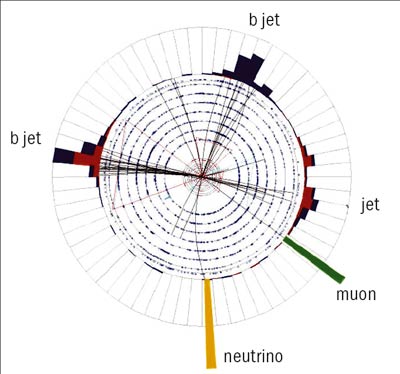
Image credit: D0 and CDF.
Almost 14 years to the day after the announcement of the discovery of the top quark in 1995, the CDF and D0 collaborations at Fermilab have announced the observation of top quarks produced singly in proton–antiproton collisions, rather than in top antitop pairs. On 4 March, the two teams submitted their independent results to Physical Review Letters. Unlike pair-production of top quarks, which occurs through the strong interaction, the production of single top quarks occurs through the weak interaction and has important implications for possible new physics beyond the Standard Model.
Only one in every 20,000 million proton–antiproton collisions produces a single top quark, and to make matters worse, the signal of these rare occurrences is easily mimicked by other “background” processes that occur at much higher rates. Both teams have previously published evidence for single top production at Fermilab’s Tevatron, CDF last year and D0 in 2007. These earlier papers reported significance levels of 3.7 σ and 3.6 σ for CDF and D0, respectively. Now both teams report the first observation of the process with a significance of 5.0 σ, based on 3.2 fb–1 of proton–antiproton collision data in CDF and 2.3 fb–1 in D0.

Image credit: D0 and CDF.
Examples of single top quark candidates in D0 (see other image) and CDF. In both events the top quark decays and produces a b quark jet, a muon and a neutrino. In the CDF event (this image), the arrow indicates the direction of the escaping neutrino.
Image credit: D0 and CDF.
The analyses also constrain the magnitude of |Vtb|, an important parameter of the Standard Model’s Cabibbo-Kobayashi Maskawa (CKM) matrix, which describes how quarks can change from one type to another. If the CKM matrix describes the intermixing of only three generations of quarks – with top and bottom forming the third generation – the value of |Vtb| should be close to one. In the new analysis CDF finds |Vtb| = 0.91 ± 0.11(stat.+syst.) ± 0.07(theor.), while D0 reports |VtbfL| = 1.07±0.12 where fL is the strength of the left-handed coupling between the W boson and the top and bottom quarks.
In addition to its inherent success, discovering single top quark production has presented the collaborations with challenges similar to the search for the Higgs boson, in terms extracting an extremely small signal from a large background. Advanced analysis techniques pioneered for the single top discovery are now in use in both collaborations for the Higgs boson search.
Further reading
CDF Collaboration 2009 http://arxiv.org/pdf/0903.0885v1.
D0 collaboration 2009 http://arxiv.org/pdf/0903.0850v1.ft.








